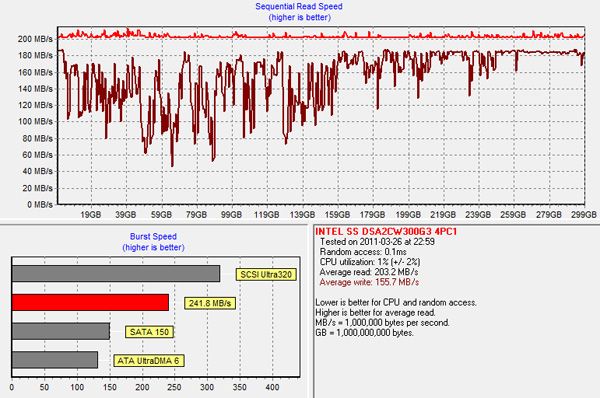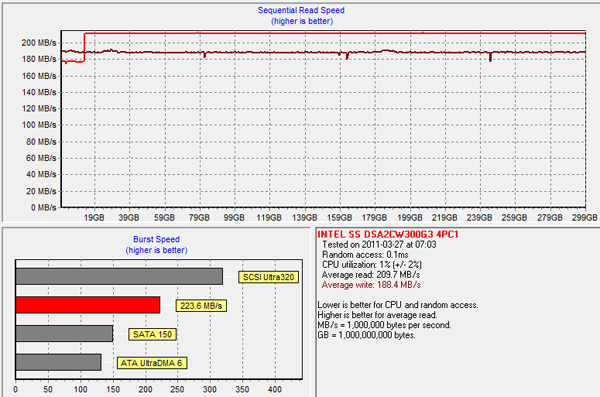The Intel SSD 320 Review: 25nm G3 is Finally Here
by Anand Lal Shimpi on March 28, 2011 11:08 AM EST- Posted in
- IT Computing
- Storage
- SSDs
- Intel
- Intel SSD 320
TRIM Performance
To test TRIM functionality we'll start off with a freshly secure erased Intel SSD 320:

Next we've filled up the 320 and tortured it with random writes for 20 minutes:

The 320 behaves a lot like the old X25-M G2 did when tortured. Minimum performance drops pretty low - Intel prefers cleaning up as late as possible to extend drive longevity. As a result, I wouldn't recommend using the 320 in an OS without TRIM support.
The format command in Windows 7 triggers TRIM across all of the drive's LBAs. The result is performance is nearly fully restored:











194 Comments
View All Comments
anthonyjcho - Thursday, November 17, 2011 - link
I just got the 40GB version of this drive for my work computer as a cache drive.I have a large DB files (1-2GB) that I access frequently and I needed a "reliable" SSD for my task. Crucial and Intel came to mind, and only Intel products could be sourced. By the way, I use a OCZ SSD at home for gaming for better read performance.
Long story short,
100-105 MB/s for Read/Write is drastic improvement over the 7200rpm HDD I was using.
My work is much more productive because I don't have to wait so long for data retrieval anymore.
I highly recommend it to any data analyst.
spacehead74 - Thursday, January 5, 2012 - link
I've been finding these on Ebay for less than $200/160gb. The 5-year warranty is a great selling point when using these for laptop upgrades.sqeeek - Thursday, October 2, 2014 - link
Still using two of these as of October 2014. Not the fastest sequential r/w but the random reads + low latency are still mind-blowingly fast compared to a spinning disk. Reliability is great as well - I even bought one used.DocSportello - Monday, September 21, 2015 - link
I installed my 320 in early 2012, and it's still running strong. My first (and thus far only) SSD, so it was a huge step up from HDs.If the numbers I saw at the time were to be believed, 320's were significantly more reliable than the alternatives. I got a bit spooked by those ongoing reports of 8-megabyte crashes; was it just a matter of time until that happened to me? But those reports mostly involved a system crash and usually a power loss; that's rare for me on a desktop with a quality power supply and a UPS.
Anyway, for whatever reason, my 320 is doing well. The specs claimed a million hours MTBF; what did the real numbers turn out to be? Oddly, the SSD Toolbox shows less than a thousand hours of power-on time, which would be unbelievably low, except I saw a post somewhere suggesting that that number is more a count of read/write activity than powered on and ready.
If I were buying today, I'd look at a Samsung 850, figuring the 40 nm cells have got to be inherently more robust than today's typical 19 nm cells. But that's theory; meanwhile the Intel 320 keeps rolling along.